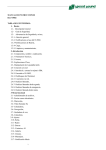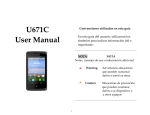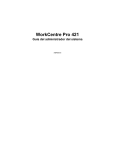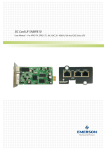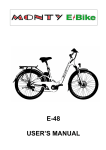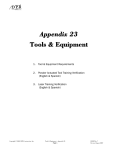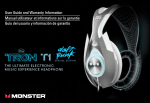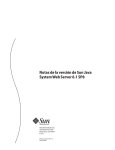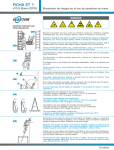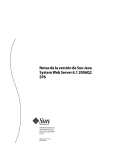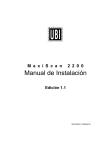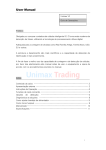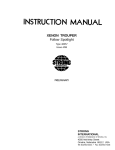Download Cranes and Material Handling Devices
Transcript
Appendix 4 Cranes & Material Handling Devices Table of Contents 1. Cranes & Material Handling Device Requirements 2. Forklift Inspection Form (English & Spanish) 3. Forklift Operator Proficiency Evaluation (English & Spanish) 4. Forklift Hand Signals 5. Crane Subcontractor Pre-Planning Package 6. Crane Hand Signals 7. FAA Notification Worksheet & Instructions 8. Mobile Crane Inspection Checklist Form 9. Heavy Equipment Inspection Form (English & Spanish) 10. Heavy Equipment Training Verification (English & Spanish) 11. Concrete Pump Pre-Planning Package 12. Concrete Pump Hand Signals 13. Concrete Pump Awareness Training Verification (English & Spanish) Copyright © 2001 DPR Construction, Inc. Cranes & Material Handling Devices - Appendix 4 Page 1 EHSP Rev 7 Revised August 2007 Cranes & Material Lifting Devices 1.0 Introduction Proper procedures must be followed to ensure that crane/lifts and lifting devices handle loads properly, safely and with maximum efficiency. All lifting activities should be performed in accordance with manufacturer’s specifications. Each appropriate subcontractor must review these procedures and provide assurance to the DPR project management that these procedures have been and will be followed. Prior to the selection, delivery, erection, use or removal of any crane/lift equipment, DPR project management will review this section of the DPR EHSP with the subcontractor's project management to ensure and enforce their compliance. Inspection reports must be provided for crane/lifts and lifting devices, shovels, derricks, tractors and pans as verification that items have been inspected by a competent, authorized person. Rated load capacities, operating instructions and special hazard warnings should be conspicuously posted on all equipment and should be visible to the operator while at the control station. An illustration of the hand signals to crane/lift operators should be posted at the job site. DPR EHS must be notified, with proper documentation provided, prior to on-site arrival of any crane/lift. Notification to DPR must be 24 hours prior to first lift, or 72 hours for critical lifts. 1.1 Pre-Task Planning All hoisting and rigging activities, as well as material handling are activities defined by DPR to be High Hazard and therefore require detailed, written pre-task planning. Refer to the Pre-Task Planning Appendix for additional guidelines and PTP form. 2.0 Inspection Daily and annual inspections must be performed in accordance with the manufacturer's recommendations and as mandated by OSHA standards, as well as the DPR EHSP. Annual inspections, performed by a competent person, must be performed on all material lifting devices. Annual inspections must be received and reviewed by DPR project management prior to the arrival of equipment. Daily, documented inspections must be performed prior to lifting each day with documentation maintained on the unit. Additionally, crane/lifts and lifting devices must be inspected after set up and prior to initial lift, before each shift, and after every malfunction or incident. 2.1 Daily/Annual Inspections Daily/annual inspections must be performed, to include at a minimum, the following items: • All control mechanisms for maladjustment interfering with proper operation • All control mechanisms for excessive wear of components and contamination by lubricants or other foreign matter • All safety devices for malfunction or defect • Deterioration or leakage in air or hydraulic systems • Crane hooks with deformation or cracks • Sling and choker for broken strands, fraying or kinking • Electrical apparatus for malfunction, defect, signs of excessive wear, dirt and moisture accumulation Copyright © 2001 DPR Construction, Inc. Cranes & Material Handling Devices - Appendix 4 Page 2 EHSP Rev 7 Revised August 2007 2.2 Rigging/Lifting Devices • No chain slings are permitted on site • Daily visual inspections are required • Monthly documented inspections required • All defective rigging/lifting devices should be immediately destroyed and removed from service • Job or shop hooks and links, or makeshift fasteners formed from bolts, rods or other such attachments, will not be used • When U-bolts are used for eye splices, the U-bolt will be applied so the "U" section is in contact with dead end of rope 2.3 General Hoisting & Rigging Guidelines • Bundles of decking should only be single picked; nylon chokers should not be used for picking bundles of decking • A qualified rigger should inspect the rigging at minimum daily • Safety latches on hooks should not be de-activated or made inoperable • All suspended loads should be pre-planned to ensure that no employees are working below except for those involved in landing and connecting loads • All loads should be rigged by a qualified rigger • Tag lines or other suitable means of controlling a load are to be used at all times 3.0 Steel Erection Activities Refer to the Steel Erection Appendix for specific guidelines on activities associated with steel erection and miscellaneous metals placement. 4.0 Record Keeping In addition to documented daily, monthly and annual inspection records, all records pertaining to crane/lift inspections should be kept with the crane/lift or in the subcontractor's site field office. Valid certificates of insurance should be retained on file for each crane on site. If during any safety inspection, the operator or supervisor cannot produce the required crane/lift inspection sheets, the crane/lift should be shut down as soon as possible and must be inspected. Copies of daily/monthly inspections must be submitted to DPR project management on a weekly basis (originals will be kept on unit). Documents required to be provided to DPR prior to the first crane pick on site include: • Crane/lift annual certification • Crane/lift contractor’s certificate of insurance • Operator’s certification or written verification of hands on/written competency testing with specific make and model of crane/lift • Copy of load charts pertinent to specific boom configuration to be used • Written verification from crane/lift owner that maintenance has been performed pursuant to manufacturer’s recommendations • Written verification of rigger’s training Copyright © 2001 DPR Construction, Inc. Cranes & Material Handling Devices - Appendix 4 Page 3 EHSP Rev 7 Revised August 2007 5.0 Crane Selection and Set Up The operator is responsible for selecting a crane/lift of sufficient capacity and with appropriate design features to be suitable for the intended lift. The operator should comply with the manufacturer's specifications and limitations applicable to the operation of any and all crane/lifts and lifting devices and derricks. Where manufacturer's specifications are not available, the limitations assigned to the equipment should be based on the determinations of a qualified engineer competent in this field. Such determinations should be appropriately documented and recorded and available at the job site. All cranes will be equipped with an integrated anti-two block system. Any crane not equipped with an integrated anti-two block system must be approved by DPR project management prior to mobilization. Once the appropriate crane/lift has been selected, the operator should be responsible for obtaining the proper permits to transport the equipment to the site. The delivery of the crane/lift should be scheduled by the operator with DPR project management and local agencies with jurisdiction over routes of transportation and any utilities that may need to be cleared. 5.1 Crane Operator Responsibilities At the site, the operator will be responsible for the following: • The proper placement of the crane/lift in relationship to the load to be handled and the landing area so as to obtain the best rated lift capacity • Leveling the crane/lift to within 1 degree of level and reassuring the level, a minimum of three times, during each 8-hour work shift • The proper placement and use of outriggers for all lifts, except where the manufacturer permits otherwise for assembly of boom only • The determination of stable or unstable ground or footing • Should additional floats, cribbing, timbers or other structural members be needed, they should be of proper design and sufficient to uniformly distribute the load • The installation and maintenance of crane/lift swing radius protection • Completion of daily/monthly inspections 5.2 FAA Notification Construction equipment or other temporary structures such as cranes, derricks, stockpiles of equipment and earth moving equipment are examples of structures that require notice to the FAA when the following conditions apply: • When they are greater than 200 feet above the ground level at their location • When they are near an airport or heliport. “Near” is defined by the FAA as: o within 20,000 feet of a major airport and the height of the object exceeds the slope of 100:1 horizontally (e.g., a structure located at 10,000 feet will require notice when it exceeds 100 feet in height) o within 10,000 feet of a minor airport and the height of the object exceeds the slope of 50:1 horizontally o within 5,000 feet of a heliport and the height of the object exceeds the slope of 25:1horizontally • When they are located on an airport or heliport • When requested by the FAA Notice to the FAA should be submitted at least 30 days before the date the proposed construction or alteration is to begin. Notice will be made on FAA Form 7460-1, Notice of Proposed Construction or Copyright © 2001 DPR Construction, Inc. Cranes & Material Handling Devices - Appendix 4 Page 4 EHSP Rev 7 Revised August 2007 Alteration found at the end of this Appendix. Maps and/or charts may also be required that accurately depict the precise location of the proposed construction or alteration relative to the affected airport or heliport. To assist in the planning and development of maps and in calculating distance the following websites may help: • topozone.com for latitude and longitude coordinates of the proposed construction or alteration and the edge of the nearest airport or heliport • http://jan.ucc.nau.edu/~cvm/latlongdist.html for calculating distances based on latitude and longitude For more assistance in the FAA requirements or in determining the need for notification, contact your regional FAA office or see DPR Toolbox. ADDRESSES OF THE REGIONAL OFFICES Eastern Region DC, DE, MD, NJ, NY, PA, VA, WV Eastern Regional Office Air Traffic Division, AEA-520 JFK International Airport Fitzgerald Federal Building Jamaica, NY 11430 Tel: 718-553-2616 Southern Region AL, FL, GA, KY, MS, NC, PR SC, TN, VI Southern Regional Office Air Traffic Division, ASO-520 1701 Columbia Avenue College Park, GA 30337 Tel: 404-305-5685 Southwest Region AR, LA, NM, OK, TX Southwest Regional Office Air Traffic Division, ASW-520 2601 Meacham Boulevard Fort Worth, TX 76137-0520 Tel: 817-222-5531 Western Pacific Region HI, CA, NV, AZ, GU Western-Pacific Regional Office Air Traffic Division, AWP-520 15000 Aviation Boulevard Hawthorne, CA 90260 Tel: 310-725-6557 5.3 Load Ratings The operator will be responsible for making the following determinations: • The weight of all auxiliary handling devices such as hoist blocks, headache balls, hooks and rigging should be considered by the operator as part of the total load • Additionally, the weight of all items added to the load at the site must be determined and added to the total weight NOTE: Some manufacturers require that the load cable also be considered as part of the total load weight. • The operator should obtain a copy of the Bill of Lading with the item weight clearly legible, and: o this information will be used to determine total load weight o each delivery received at the site should be accompanied by a Bill of Lading with the item weight clearly indicated Copyright © 2001 DPR Construction, Inc. Cranes & Material Handling Devices - Appendix 4 Page 5 EHSP Rev 7 Revised August 2007 o items received at the site without a legible item weight should be refused and the responsible subcontractor held accountable for any additional expense incurred and/or delays 5.4 Ground Stability One of the critical factors of proper crane/lift setup is a firm supporting surface. For maximum capacity, the crane/lift must be level. To maintain a level condition, however, the ground surface must be adequate to support the dynamic load of a working crane/lift. The operator should consider the following four basic elements: Total Imposed Load. The load on the tires, outrider wheels or tracks is derived from the sum of the gross weight of the crane/lift and the suspended load. Shock or dynamic (movement) loads (as a result of fast hoisting, lowering, swinging or wind forces) can exert additional loading. This total load must also be considered. Supporting Surface Area. The amount of area in contact with the ground will determine the bearing pressure the crane/lift and load exerts on the soil. When it is determined that the bearing pressure exceeds soil stability, the bearing area of the crane/lift must be increased by the use of cribbing. It is important that cribbing be strong enough to withstand the weight of the crane/lift without major deflection, thus, actually increasing the bearing surface. Cribbing also must be bolted or secured together to prevent slippage and collapsing and be in complete contact with the soil without any voids or insupportable areas. Bearing Pressure. The bearing pressure on the corner outrigger is a greater percentage of the total imposed load on that outrigger when the load is moving over that cover outrigger. The load percentage on each corner will vary depending on the type of crane/lift and operating radius. A good rule to follow is to assume each corner is carrying 85 percent of the total load. Thus, an example calculation would be: • Crane and load - 150 Tons • One 2 ft. X 2 ft. Float - 4 SF • Assume 85% of load at corner • Corner Bearing Pressure = 31.8 Tons/SF • (15OT/4SF x.85 - 31.8T/SF) Soil Stability. The bearing pressure, described above, must be compared to the load-bearing qualities of the soil. For descriptive purposes, it is convenient to distinguish between three broad groups of soil: • Granular soils, including sand and gravel • Fine grained soils, including silts and clays • Organic soils, including peat Different soil types give different load-bearing pressure. When setting up a machine, the operator should be able to distinguish between the three groups of soil, the approximate mixture of each, their moisture content and their depth. Factors such as water tables and distance to excavation which affect the soil's ability to withstand the pressure without collapsing must also be considered by the operator. Tables are available listing the relative load bearing capabilities of the soil types under static loads. Local building code requirements and the project soil boring logs should be considered by the operator in evaluating the soil bearing capacity prior to erection of a crane/lift. Copyright © 2001 DPR Construction, Inc. Cranes & Material Handling Devices - Appendix 4 Page 6 EHSP Rev 7 Revised August 2007 6.0 Critical Lift A critical lift plan must be submitted a minimum of 72 hours in advance of the anticipated lift to DPR project management for review. Critical lifts are defined as any lift that: o any pick which puts personnel, equipment or structures at risk o gross load weight exceeds 75% of crane’s rated capacity o any lift which requires unusual rigging or procedures o any lift where the crane is supported on a structure o crane suspended personnel platform lift o tandem picks o net weight of load exceeds 25 tons o replace time for damaged load exceeds four months o any lift with energized power lines within 20’ 6.1 Critical Lift Procedures In addition to completing the Pre-Lift Checklist and Crane Pre-task Plan (refer to documents at the end of this Appendix), the following requirements apply: o All lift activities will be conducted under the direction of a qualified person. Where applicable, subcontractor’s qualified person will be approved in advance by DPR project management. The qualified person will have no other duties other than directing the lift, and will be on-site during all lifting activities. o Coordination meeting, to include a pre-job walk, should be conducted with DPR project management no more than 24 hour prior to lift. 7.0 Crane & Hoisting Equipment Operator Qualifications It is DPR’s intent that all cranes and hoisting equipment on our projects are operated by a certified operator. In lieu of certification, operators must have demonstrated competency for the specific piece of equipment being operated through hands on and written testing. It is the responsibility of the subcontractor to provide an operator meeting these requirements, and to ensure safe operating practices are followed at all times. 7.1 Operating Procedures • The operator should not engage in any practice that may divert attention while engaged in crane/lift operations, operate the crane/lift if physically or mentally unfit, taking prescription drugs that may affect judgment and should not respond to any signal which is unclear or is given by anyone other than appointed signal men (Exception: the operator should respond to a stop signal given by anyone) • The operator should not permit trainees to make initial lifts • The operator should perform the first lift to determine lift stability, crane/lift function and safety in general • The operator should have final responsibility and control over crane/lift operations • Whenever there is any doubt as to safety, the operator should have the authority to stop and refuse to handle loads until safety has been assured • The operator should be familiar with the crane/lift and its care, the operator's manual and load charts • The operator should be responsible for notifying their supervisor of any needed adjustments or repairs, and for logging their findings in the crane/lift log Copyright © 2001 DPR Construction, Inc. Cranes & Material Handling Devices - Appendix 4 Page 7 EHSP Rev 7 Revised August 2007 • • • • • • • • • • Upon request, the operator should demonstrate their ability to determine total load weight and its relationship to the crane/lift load charts No crane/lift should be loaded beyond its rated capacity, except for test purposes under controlled circumstances When loads to be handled are limited by structural competence rather than by stability, the operator and supervisor should determine concurrently that the weight of the load is known within plus or minus 5 percent before the load is lifted Loads should be attached to the hook by means of slings or other approved devices, and: o no open hooks should be used for lifts higher than 2 feet o hooks used for lifts in excess of 2 feet should have hook safety latches or be safety wired to prevent slings from jumping off the hook The operator should not suddenly accelerate or decelerate a moving load At no time should any part of the crane or any part of the load contact any obstructions The operator must not swing loads over personnel The operator must not permit side-loading of booms Lifts should be limited to freely suspended loads Cranes and lifting devices should not be used to drag loads sideways 8.0 Personnel Platform Lifting Crane or derrick suspended personnel platforms may not be used unless the erection, use and dismantling of conventional means of reaching the worksite is not possible or would be more hazardous. In addition to completing the Crane Pre-Lift Checklist and the crane Pre-Task Planning form, documentation that all individuals who are to be lifted must be obtained stating that they have been trained in personnel platform lifting protocols per OSHA, state and/or local requirements. Also, the jobsite must perform a proof test prior to hoisting employees. The platform and rigging should be proof tested to 125% of the platform’s posted rated capacity. Inspect the crane/lift, rigging and the personnel platform after the test. Refer to Fed/OSHA regulations for additional procedures to be followed when using a personnel platform lift. 9.0 Aerial and Scissor Lifts Refer to the Elevated Work Appendix for requirements for Aerial and Scissor Lift operations. 10.0 Forklifts Forklifts should be inspected each day prior to use to determine that they are in safe working condition (refer to Forklift Inspection form at the end of this Appendix or use manufacturer’s inspection guidelines) Forklifts should be operated in accordance with manufacturer’s recommendations and limitations 10.1 Forklift Training Requirements • Employees operating forklifts must be trained by a person qualified to recognize the hazards associated with aerial lifts and to understand the procedures to control or minimize those hazards • The training must be in compliance with OSHA guidelines Copyright © 2001 DPR Construction, Inc. Cranes & Material Handling Devices - Appendix 4 Page 8 EHSP Rev 7 Revised August 2007 • • • Operators must be trained on the equipment they will be operating or competency verified by a qualified person prior to vehicle operation (refer to Forklift Operator Proficiency Evaluation form at the end of this Appendix) Current certification must be maintained and presented to DPR project management upon request Certification will be revoked and refresher training provided and /or operator proficiency verified before commencement of operation when: o the operator is observed to operate the vehicle in an unsafe manner o the operator is involved in an accident or near miss incident o the operator is assigned to drive a different type vehicle o conditions in the workplace change that could affect safe operation 11.0 Heavy Equipment Heavy equipment should be operated in accordance with manufacturer’s recommendations and limitations, and operators should be trained in the safe operation of the equipment they will be utilizing. Heavy equipment should be inspected each day prior to use to determine that they are in safe working condition. An operator training verification and daily inspection form is located at the end of this Appendix. These forms are provided as a tool for use on the project, and may become mandatory at the discretion of the DPR project team. 12.0 Helicopters Helicopter operations are not to be used unless all other methods have been considered and determined to be infeasible, and approval has been granted in writing from the DPR Corporate EHS Director. 13.0 Concrete Pump Trucks Concrete pump trucks should be inspected each day prior to use to determine that they are in safe working condition (refer to Concrete Pump Truck Inspection form at the end of this Appendix or use manufacturer’s inspection guidelines) Concrete pump trucks should be operated in accordance with manufacturer’s recommendations and limitations. Coordination between the DPR project team and concrete pump truck operators should occur to ensure proper conditions are maintained during setup, use breakdown of equipment. The boom of the pump should not be used for hoisting at any time. Additionally, the following guidelines should be followed: • Overhead power lines o Power should be shut off to over head power lines whenever possible, and verified dead prior to start. o Where units must operator in proximity to energized overhead power lines, units should be set up a minimum of 17 feet away. • Hose Whipping o No added metal fitting or couplings should be used at the end of the delivery hose. o Hoses should not be allowed to become kinked. o Personnel should maintain a safe distance from the discharge upon initial startup, restart or when air is in the hose. The safe distance is equivalent to the length of the discharge hose. • Rock/Concrete Spray: o Only trained personnel should be allowed in the area near the hopper, barricading or other means of limiting access should be provided to ensure non-authorized personnel are kept away. • Environmental Hazards: Copyright © 2001 DPR Construction, Inc. Cranes & Material Handling Devices - Appendix 4 Page 9 EHSP Rev 7 Revised August 2007 o All washout activities should be completed in their designated washout area o Concrete activities should be performed so as to contain and/or minimize residue or waste water; all such wastes should be properly disposed o Refer to the Chemical & Environmental Appendix for additional environmental protection requirements. 14.0 Weather Related Impacts It will be the responsibility of the subcontractor to ensure all lifting activities are safely performed within the parameters and limitations specified in manufacturer’s operating manual. Special consideration should be given to adverse weather conditions. DPR project management reserves the right to cease any activity should weather conditions change to affect work performance. Copyright © 2001 DPR Construction, Inc. Cranes & Material Handling Devices - Appendix 4 Page 10 EHSP Rev 7 Revised August 2007 Forklift Pre-Use Inspection Archive Document – DO NOT DISCARD Model: Equipment Number: Company: Hour Meter: DATE: Initials of person performing inspection: Has the operator been instructed in the safe operation of this type of lift and are they certified? Inspection Item & Description (Pass / Fail) PRESTART 1 Fork Assembly Structure 2 Mast/Boom 3 Hydraulic Lines** 4 Wheels/Tires** 5 Axles/Under Carriage 6 Placards (legible) 7 Roll Cage – Structural 8 Operator’s Manual 9 Engine Compartment 10 All Fluid Levels 11 Belts 12 Wiring 13 Leaks/Hoses** START-UP 1 Seat Belt** 2 All Gauges 3 Warning Signs/Placards 4 Steering (loose)** 5 Levers/Switches 6 Lights/Backup Alarm** 7 Horn** FUNCTION CHECK 1 Lift up/down** 2 Telescope in/out** 3 Tilt in/out ** 4 Outriggers 5 Brakes, Parking Brake** Y/N Y/N Y/N Y/N Y/N Y/N Y/N P/F P/F P/F P/F P/F P/F P/F ** If any item(s) are found to be missing or defective, the equipment is to be repaired/serviced prior to use. Defects Reported To: _________________________________________________ Lift Taken Out of Service Yes Date: _________________________ No Repairs Made By: _________________________________________________ Copyright © 2001 DPR Construction, Inc. Date: _________________________ Cranes & Material Handling Devices - Appendix 4 Page 11 EHSP Rev 7 Revised August 2007 Inspección previa al uso del elevador de horquilla Documento de archivo – NO DESECHAR Número del equipo: Medidor de horas: Modelo: Compañía: FECHA: Iniciales del inspector: ¿Ha sido instruido el operador acerca de la operación segura de este tipo de elevador, y tiene su certificación? Sí/ No Artículo inspeccionado y descripción (aprobado/desaprobado) PRE PUESTA EN MARCHA 1 Estructura del ensamblaje de la horquilla 2 Mástil/pluma 3 Líneas hidráulicas ** 4 Ruedas/neumáticos** 5 Ejes/chassis inferior 6 Carteles (legibles) 7 Jaula antivuelcos – estructural 8 Manual del operador 9 Compartimiento del motor 10 Niveles de todos los fluidos 11 Correas 12 Cableado 13 Filtraciones/mangueras** PUESTA EN MARCHA 1 Cinto de seguridad** 2 Todos los indicadores 3 Señales de advertencia/carteles 4 Dirección (suelta)** 5 Palancas/interruptores 6 Luces/alarma de refuerzo** 7 Bocina** CHEQUEO DE FUNCIONES 1 Elevador sube/baja** 2 Telescopio entra/sale** 3 Inclinación dentro/fuera ** 4 Estabilizadores 5 Frenos, freno de mano** A/D Sí/ No A/D Sí/ No A/D Sí/ No A/D Sí/ No A/D Sí/ No A/D Sí/ No A/D ** Si se encuentra cualquier artículo faltante o defectuoso, el equipo deberá ser reparado o recibir servicio de mantención antes de su uso. Defectos reportados A: _________________________________________________ Elevador retirado de servicio Sí Fecha: _________________________ No Reparaciones hechas Por: _________________________________________________ Copyright © 2001 DPR Construction, Inc. Fecha: _________________________ Cranes & Material Handling Devices - Appendix 4 Page 12 EHSP Rev 7 Revised August 2007 Forklift Operator Proficiency Evaluation Archive Document – DO NOT DISCARD Employee Name Testing Date Equipment Manufacturer Model Project Capacity Pre-Start Inspection 1. 2. 3. 4. 5. 6. 7. 8. 9. 10. 11. 12. 13. 14. 15. FAIL PASS FAIL Assure that no repairs are in progress Check all fluid levels Check tires/wheels Check for oil leaks Check the brakes Check all hoses Check battery Check lights Check horn Check back-up alarm Check fire extinguisher Operator knows the capacity of forklift Check operation of controls Capacity chart posted Operator’s manual in cab Operating Skills Evaluation 1. 2. 3. 4. 5. 6. 7. 8. PASS Does operator drive at a safe rate of speed? Did operator slow down at stops or intersections? Did the operator approach the load cautiously? Does the operator know the weight of the load? Did the operator place the forks under the load properly? Did the operator raise and position the load properly? Did the operator strike anything while moving the load? Is the seat belt worn while operating? ___________________________________ _________________________________________ Operator Name (Print) Examiner Name (Print) ___________________________________ _________________________________________ Operator Signature Examiner Signature Copyright © 2001 DPR Construction, Inc. Cranes & Material Handling Devices - Appendix 4 Page 13 EHSP Rev 7 Revised August 2007 Evaluación del desempeño del operador de un elevador de horquilla Documento de archivo – NO DESECHAR Nombre del empleado Fecha del examen Equipo Fabricante Modelo Proyecto Capacidad Inspección antes de la puesta en marcha 1. 2. 3. 4. 5. 6. 7. 8. 9. 10. 11. 12. 13. 14. 15. 3. 4. 5. 6. 7. 8. DESAPROBADO APROBADO DESAPROBADO Chequear que no exista una reparación en curso Chequear todos los niveles de fluidos Chequear ruedas y neumáticos Chequear filtraciones de aceite Chequear los frenos Chequear todas las mangueras Chequear la batería Chequear luces Chequear bocina Chequear la alarma de refuerzo Chequear el extinguidor de incendios Operador conoce la capacidad del elevador de horquilla Chequear la operación de los controles Tabla de capacidades a la vista Manual del operador en la cabina Evaluación de capacidad de operación 1. 2. APROBADO ¿Maneja el operador a una velocidad prudente? ¿Redujo el operador la velocidad en los signos “Pare” o en las intersecciones? ¿Se acercó el operador con cuidado a la carga? ¿Conoce el operador el peso de la carga? ¿El operador colocó correctamente las horquillas debajo de la carga? ¿El operador levantó y colocó la carga adecuadamente? Al mover la carga, ¿chocó con algo el operador? ¿Usó el cinto de seguridad durante la operación? Nombre del operador (letra de imprenta) Nombre del evaluador (letra de imprenta) Firma del operador Firma del evaluador Copyright © 2001 DPR Construction, Inc. Cranes & Material Handling Devices - Appendix 4 Page 14 EHSP Rev 7 Revised August 2007 Forklift Hand Signals Copyright © 2001 DPR Construction, Inc. Cranes & Material Handling Devices - Appendix 4 Page 15 EHSP Rev 7 Revised August 2007 Crane Subcontractor Pre-Planning Package Date: Dear Subcontractor The following package is provided to you to assist you and your workers in maintaining an Injury Free Environment. As you know, crane operations are very hazardous and there are many steps necessary prior to a crane arriving on the project. Though crane accidents rarely occur, when they do there are usually serious consequences such as loss of life, property or otherwise. Please review and complete the following documentation. These should be filled out as completely as possible and submitted to DPR at least 24 hours prior to first pick (72 hours for critical lifts). Required documentation: 1) Please complete the Pre-Lift Checklist as completely as possible. 2) Provide copies of annual crane certification. a. Certification must match the crane that shows up on site. b. Certification must be current. c. Crane must have passed certification; including verification of completed repairs identified at time of certification. 3) Provide copies of insurance. a. Insurance must include general liability. b. As needed, insurance must include excess liability insurance. c. If the equipment or material to be lifted is in excess of $50K in value, then additional riggers or hook liability insurance will be needed. d. DPR and the owner must be named additional insured. e. Insurance must be valid (i.e., not expired). 4) Operator’s certification or written verification of hands on/written competency testing with specific make and model of crane/lift. 5) Copy of load charts pertinent to specific boom configuration to be used. 6) Written verification from crane/lift owner that maintenance has been performed pursuant to manufacturer’s recommendations. 7) Written verification of rigger’s training. 8) Complete a pre-task/pre-lift plan, detailing likely sequencing and what safety precautions will be taken to address any potential hazards. A pre-task plan checklist and worksheet have been provided. Safety items to consider: a. Fall Protection e. Guarding b. Public and worker exposure f. Crane Set-up c. Weather g. Rigging d. Communication h. Control of Load/Pinch points Additionally: 1) A safety meeting will be held before the lift with the crew to review all of the above listed items. 2) A daily inspection (as required by OSHA) must be performed on all cranes. Typically these inspection logs will already be with the cranes. A sample inspection form is provided. 3) For steel erection activities, refer to Steel Erection Appendix for specific guidelines on hoisting and lifting. This package is designed to assist you in running a smooth and safe operation while on our projects. If you have any questions regarding any information contained within, please contact the DPR Project Team. Thank you for your assistance in helping us to create an Injury Free Environment. DPR Construction, Inc. Copyright © 2001 DPR Construction, Inc. Cranes & Material Handling Devices - Appendix 4 Page 16 EHSP Rev 7 Revised August 2007 Crane Pre-Lift Checklist Archive Document – DO NOT DISCARD Job Name: Contractor Requesting Crane: Contractor Providing Crane: Job Number: Date: Date Crane will be Lifting: Date of Crane Arrival: You must contact DPR project management at least one (1) day prior to any lift. Documentation Valid crane/lift certification with all repairs completed Written verification from crane/lift owner that maintenance has been performed pursuant to manufacturer’s recommendations. Verify operator’s certification or obtain written verification of hands on/written competency testing with specific make and model of crane/lift. Verification of rigger’s training. Subcontractor to submit copies of load charts pertinent to specific boom configuration to be used. Obtain a copy of the crane/lift contractor’s certificate of insurance with additional insured endorsement, Verify limits are within terms and conditions per DPR contract. Verification of meeting FAA requirements (as required). Prior to approval of multi-loading, documentation verifying safety protocols being taken must be received and approved by DPR. Complete detailed, written pre-task planning with operator, oiler, and crew and foreman involvement. Contractor to submit a written plan 24 hours prior to crane/lift arrival (72 hours for critical lifts), to include: An Erection Plan for steel erection activities. Start & finish times for all lifts. A detailed fall protection plan. A detailed list of protective measures for workers, the environment, and the public. Crane set-up locations, with swing path, travel plan and load positions Hoisting/Rigging Plan (single pick preferred, maximum 3 members w/approved multi-rigging assembly) Communication Plan Cut sheets on all units to be lifted, including weights and dimensions or documentation stating the same as well as the anticipated load calculations Pre-Mobilization DPR Superintendent and Requesting Crane/Lift Contractor perform site walk. Review, at minimum: Integrated anti-two block system. Condition of asphalt, concrete, soil, etc. where crane/lift will be set-up & operating. Location of overhead electrical lines. • Rated line voltage: kv • Distance of lift to lines: ft. • Lines Energized? Yes (distance must be greater than 15’, unless over 200kV, then greater than 20’) No (contact owner and ground lines) • Person designated to observe line clearance for operation: Crane/Lift contractor to provide: Gross capacity of crane/lift to be used. Net Capacity of crane/lift (maximum load weight + blocks + rigging = total weight) Maximum Radius: Maximum Boom Length: Minimum Boom Angle: Building height: Sling(s) type: Sling(s) angle: Sling(s) capacity: Accessory (i.e., Shackles) capacity: Mobilization – Continuous throughout Operation Operator and crew complete site safety orientation. Determine operator’s qualifications and length of experience with specific make and model of crane/lift. Documentation of Crane Assembly Safety Meeting and Boom Inspection. A copy of the manufacturers Operating Manual is on the crane/lift. A minimum of a 5 BC portable fire extinguisher with current maintenance tag is on the crane/lift. Conduct a safety meeting, covering at least: Weather conditions & related impacts Maximum wind speed per Manufacturer verified Evacuation plan Rigging procedures Verify & review means of communication Safety precautions working around the crane. Public protection Outriggers must be fully extended, pads level, on solid bearing, and pinned. Retracting outriggers without a signal man is prohibited. Barricading in place to protect the swing of crane and for traffic control. Rigging is in good condition & additional rigging is available. Signal Man: Ensure these are in place: Hard hats PPE (safety glasses, gloves, vests etc) Fall Protection (harnesses, lanyards etc.) Taglines There is no work under the load or pinch points Signatures DPR Superintendent or EHS Crane Contractor Supervisor Lift Requesting Contractor Supervisor Distance to neighboring buildings, roadways, and walkways. Copyright © 2001 DPR Construction, Inc. Cranes & Material Handling Devices - Appendix 4 Page 17 Qualified Person for Critical Lift EHSP Rev 7 Revised August 2007 Crane & Material Lifting Pre-Task Plan Archive Document – DO NOT DISCARD Date: ____________Job Name: Specific Location of Work: Company: ________________________________ Answer the following when evaluating your work (circle YES, NO or N/A): Are any of the Following Required? 1. Have you walked your work area to identify live systems, overhead lines, utilities, underground conditions, public exposures, lighting, etc? YES NO N/A 2. Are there any hazards created by any other workers in your area or does your work create hazards for others? YES NO N/A Hard Hat 3. Have all rigging, equipment and tools been inspected prior to use? YES NO N/A Fall Protection 4. Are materials, tools and manpower adequate to perform the job safely? YES NO N/A Eye / Face PPE 5. Have weights of all loads been verified? YES NO N/A Hand / Arm PPE 6. Is this a critical lift? (i.e. load exceeds 75% of crane capacity, or puts personnel, equipment or structures at risk, etc.) YES NO N/A Hearing PPE 7. Does this task require any additional permits or procedures? (FAA Notification, OSHA Permit, etc.) YES NO N/A Foot PPE 8. Have you addressed any barricading, warning system or signage requirements appropriate to the task? YES NO N/A Respirator 9. Have you established a communication system for signaling? YES NO N/A Personal Protective Equipment: Locate: 10. Are outriggers fully extended with adequate pads? YES NO N/A Emergency Telephones 11. Have all riggers been trained in safe rigging practices? YES NO N/A Fire Extinguisher 12. Will this task require any lifting, bending or twisting? Have you completed Stretch & Flex today? YES NO N/A Emergency Exit Routes 13. Are enough people assigned to safely complete the task? (lifting, spotting, guiding w/taglines etc.) YES NO N/A First Aid Equipment 14. Is there a new hire, or new team member on the project who will need support? YES NO N/A Other___________ 15. Do you have an injury to report or were you injured the prior working day? YES NO N/A Other___________ Any safety item identified in the above question list must be addressed on the back page Task: A: Steps for Work B: Tools C: Hazards *If you need more space, attach another PRE-TASK PLAN SHEET D: Steps Taken to Address Hazards **If you need a work diagram, attach it on a separate sheet of paper Work Planner (your name): ______________________ Foreman Name:______________________ Safety Coordinator: ___________________________ Crew Members: Pretask Plan Audited? M Tu W Th Work Area Cleaned Up? M Tu W Th Cords Rolled Up? M Tu W Th Copyright © 2001 DPR Construction, Inc. Cranes & Material Handling Devices - Appendix 4 Page 18 EHSP Rev 7 Revised August 2007 F F F LIFT PLAN – Please draw a map to detail set-up points, sequencing of picks, protection etc. Copyright © 2001 DPR Construction, Inc. Cranes & Material Handling Devices - Appendix 4 Page 19 EHSP Rev 7 Revised August 2007 Crane Hand Signals Copyright © 2001 DPR Construction, Inc. Cranes & Material Handling Devices - Appendix 4 Page 20 EHSP Rev 7 Revised August 2007 Copyright © 2001 DPR Construction, Inc. Cranes & Material Handling Devices - Appendix 4 Page 21 EHSP Rev 7 Revised August 2007 Copyright © 2001 DPR Construction, Inc. Cranes & Material Handling Devices - Appendix 4 Page 22 EHSP Rev 7 Revised August 2007 Month: Mobile Crane Inspection Checklist Equipment #: Archive Document – DO NOT DISCARD Note: if used by more than one operator, each operator is to place their initials in the appropriate box(s) and sign where indicated, or use separate sheet. Day of the Month: 1 2 3 4 5 6 DAILY Service and Maintenance Inspection 1. Check brakes, motors, drums, gearboxes, bearings and drive alignment. 2. Inspect ropes, cables and hoist spooling 3. Check air/hydraulic/electrical components for wear and damage. 4. Servicing (as per manufacturer’s recommendations). 5. Inspect rigging, hooks, slings and shackles. 6. Test boom angle indicator and other safety devices. 7. Check anti-two block device. 8. Check outriggers and pads. 9. Check fluid levels and lubrication as require. 10. Check cable rollers, track, slewing rings and rollers. 11. Check structural bolts and pins. 12. Check structure for cracks and buckling. 13. Check walkways, handrails and ladders. 14. Check in-cab controls, cab glass, fire extinguisher. 7 8 9 10 11 12 13 Remarks: Investigate unusual noises or problems, record corrective action(s) here. Operator’s signature: WEEKLY Service and Maintenance Inspection: Check structural bolts and pins. Check all moving parts: Gears, shafts and drives Sheaves, bushings and pins Rollers, tracks and slewing rings Guy ropes, pendant lines, cable clips, thimbles and ferrules 3. Counterweight support. 4. Job backstops (boom stops) Remarks: Record corrective action(s) here: Operator’s signature: MONLTHY Service and Maintenance Inspection: 1. Examination of hoist cables Remarks: Record corrective action(s) here: Operator’s signature: ANNUAL Service and Maintenance Inspection: 1. Examine all winches and test line pull to manufacturer’s specifications. 2. Drive transmissions and power equipment, ring gear assembly. 3. Non-destructive test: Boom, mast, counterweight, jib, staybacks, guy lines and pendant lines, outriggers (beams and boxes) All load carrying equipment sheaves, blocks, rings, shackles, hooks, chains and slings Remarks: Record corrective action(s) here: Operator’s signature: NOTE: It is intended that the equipment be checked daily and weekly by the operator. Any defect must be reported under the space(s) left for remarks. The weekly inspections do not relieve the operator of the responsibility to perform daily inspections and to report any fault immediately. Refer to requirements in OSHA Standards 29CFR 1910.180 and 1926.550. 1. 2. Copyright © 2001 DPR Construction, Inc. Cranes & Material Handling Devices - Appendix 4 Page 23 EHSP Rev 7 Revised August 2007 14 15 Month: Mobile Crane Inspection Checklist Equipment #: Archive Document – DO NOT DISCARD Note: if used by more than one operator, each operator is to place their initials in the appropriate box(s) and sign where indicated, or use separate sheet. Day of the Month: 16 17 18 19 20 21 22 DAILY Service and Maintenance Inspection 15. Check brakes, motors, drums, gearboxes, bearings and drive alignment. 16. Inspect ropes, cables and hoist spooling 17. Check air/hydraulic/electrical components for wear and damage. 18. Servicing (as per manufacturer’s recommendations). 19. Inspect rigging, hooks, slings and shackles. 20. Test boom angle indicator and other safety devices. 21. Check anti-two block device. 22. Check outriggers and pads. 23. Check fluid levels and lubrication as require. 24. Check cable rollers, track, slewing rings and rollers. 25. Check structural bolts and pins. 26. Check structure for cracks and buckling. 27. Check walkways, handrails and ladders. 28. Check in-cab controls, cab glass, fire extinguisher. 23 24 25 26 27 28 29 Remarks: Investigate unusual noises or problems, record corrective action(s) here. Operator’s signature: WEEKLY Service and Maintenance Inspection: Check structural bolts and pins. Check all moving parts: Gears, shafts and drives Sheaves, bushings and pins Rollers, tracks and slewing rings Guy ropes, pendant lines, cable clips, thimbles and ferrules 7. Counterweight support. 8. Job backstops (boom stops) Remarks: Record corrective action(s) here: Operator’s signature: MONTHLY Service and Maintenance Inspection: 2. Examination of hoist cables Remarks: Record corrective action(s) here: Operator’s signature: ANNUAL Service and Maintenance Inspection: 4. Examine all winches and test line pull to manufacturer’s specifications. 5. Drive transmissions and power equipment, ring gear assembly. 6. Non-destructive test: Boom, mast, counterweight, jib, staybacks, guy lines and pendant lines, outriggers (beams and boxes) All load carrying equipment sheaves, blocks, rings, shackles, hooks, chains and slings Remarks: Record corrective action(s) here: Operator’s signature: NOTE: It is intended that the equipment be checked daily and weekly by the operator. Any defect must be reported under the space(s) left for remarks. The weekly inspections do not relieve the operator of the responsibility to perform daily inspections and to report any fault immediately. Refer to requirements in OSHA Standards 29CFR 1910.180 and 1926.550. 5. 6. Copyright © 2001 DPR Construction, Inc. Cranes & Material Handling Devices - Appendix 4 Page 24 EHSP Rev 7 Revised August 2007 30 31 Heavy Equipment Inspection / Inspecion de Equipo Archive Document – DO NOT DISCARD Job Name/Nombre de Sitio: Operator Name / OIperador: Company / Compania: Model / Modelo: Last Oil Change / Untimo Cambio de Acieta: Foreman / Miodomo: Current Hours / Horas Corriente Equipment Number / Equipo de numero: Date/ Feche: Initials of person performing inspection: Initiales de persona realizar inspeciones: Inspection Item / Description (Ok/R/A) 1 2 3 4 5 6 7 8 9 10 11 12 13 14 15 16 17 18 19 20 21 22 Ok/R/A Ok/R/A Ok/R/A Ok/R/A Ok/R/A Cab Clean / Limpieza de Cabina Operator’s Manual / Manuel de Operacion Horn / Cuerno de Vehiculo Mirrors / Espejo Fire Extinguisher / Extinguisher de Fuego Seatbelt or ROPs / Cinturon de Seguridad Glass & Wipers / Ventanta & Limpiaparabrisas Gauges (pressure check) / Safety triangles (if aplicable) / Backup Alarm / Alarma Secundaria Steering & Brakes / Volante & Freno Lights & Blinkers / Luces & Indicador Engine Oil or Leaks / Aceite de Motor o Escape Transmission Oil / Aceite de Transmission Hydraulic Oil / Aceite de Hidraulico Coolant Leaks / Escape de Refrigerante Tires & Rims / Llanta y Rines Panels & Covers / Paneles y Cubiertas Exhaust Leaks / Escape de Gases Belts / Cinto Pívot Pins / Clavos de Pivote Bucket condition / Condicion de Bote R – Repair needed R – Reparacion Necesitado A – Added A - Agregar To: ________________________________________________________________ Copyright © 2001 DPR Construction, Inc. Cranes & Material Handling Devices - Appendix 4 Page 25 Legend / Legendario mequira Defects Reported Yes Ok/R/A OK – checked okay OK – esta bien la ** If any item(s) are found to be missing or defective, the equipment is to be repaired/serviced prior to use. Equipment Taken Out of Service Ok/R/A Date: _________________________ No EHSP Rev 7 Revised August 2007 Heavy Equipment Training Verification Form Archive Document – DO NOT DISCARD Name: Date: Jobsite: Company: Pre-planning • • • • Operators should be trained in the safe operation of the equipment they will be utilizing, and understand the equipment’s limitations. Utilities have been located and marked prior to start of work; critical systems/utilities have been pot holed (potholing requirements per the DPR EHSP have been reviewed and understood). Where applicable, the operator should reference blue prints and as-builts pertinent to the work area. Operator’s manual is readily available on the equipment. Inspection • Perform equipment inspection per operator’s manual. At a minimum, ensure the following are inspected: o Ensure cab is free of loose materials and debris. o Ensure operator’s manual is in the cab and in legible condition. o o Check tires for cuts, bulges, chunking and proper inflation o Check for proper level of fluids and ensure no leaks are present o Check that belts, air pressure, air filter, etc are in place and in good working condition, o All fittings should be adequately greased o Look for broken welds, cracks in the paint/metal or obvious damage o Inspect roll over protection for tightness of bolts/quality of welds, seat belt is in place and operational Operation • • • • • • • • • • When mounting or dismounting, maintain three points of contact with the machine at all times. Use proper start procedures, consult the operator’s manual for equipment specific requirements. Perform equipment inspection. Allow the equipment to warm up prior to operating the machine If applicable, the slope angle should be kept to a minimum. If applicable, set stabilizers and raise the machine slightly off the ground, ensure the machine is level. Make sure ALL personnel and other equipment are clear of the work area, and be alert to other people & equipment Match ground speed with conditions of terrain Allow no riders If applicable, keep the bucket low for stability and visibility Signature of employee Signature of person conducting verification review A copy of this form should be faxed to the DPR regional office PRIOR TO START OF WORK. Copyright © 2001 DPR Construction, Inc. Cranes & Material Handling Devices - Appendix 4 Page 1 EHSP Rev 7 Revised August 2007 Formulario de Verificación de Equipos Pesados Documento para archivo – NO DESECHAR Nombre: Fecha: Sitio: Compañía: Planificación previa • • • • Los operadores deben recibir capacitación sobre el funcionamiento seguro del equipo que utilizarán, y entender las limitaciones de los equipos. Se deben ubicar y marcar los servicios públicos antes de comenzar el trabajo y hacer los pozos necesarios en los sistemas/servicios públicos de primera necesidad (se deben revisar y entender los requisitos para hacer pozos de acuerdo con la política EHSP de DPR). El operador debe consultar los planos y los dibujos pertenecientes al área de trabajo, si corresponde. El manual del operador debe estar disponible en el equipo. Inspección • Inspeccione el equipo según el manual del operador. Debe inspeccionar, como mínimo, lo siguiente: o Verifique que no haya materiales sueltos ni escombros en la cabina. o Verifique que el manual del operador se encuentre en la cabina y que se pueda leer bien. o Revise los neumáticos para ver si están combados, si tienen cortes, si emiten ruidos y si tienen el nivel de inflado apropiado. o Revise que el nivel de fluidos sea el correcto y que no haya ninguna pérdida. o Verifique que los cinturones de seguridad, la presión de aire, el filtro de aire, etc., estén en su lugar correcto y en buenas condiciones. o Todos los accesorios deben estar adecuadamente engrasados. o Verifique que no hayan soldaduras rotas, grietas en la pintura/metal o daños visibles. o Para inspeccionar la protección contra vuelcos verifique que los pernos estén ajustados correctamente, revise la calidad de las soldaduras y que los cinturones de seguridad estén en su lugar y en buen funcionamiento. Operación • • • • • • • • • • Cuando deba subirse o bajarse de una máquina, mantenga tres puntos de contacto con la máquina en todo momento. Inicie la puesta en marcha del equipo de la manera correcta, consultando los requisitos específicos de los equipos en el manual del operador. Realice una inspección de los equipos. Deje que el equipo se caliente antes de operar la máquina. El ángulo de inclinación debe mantenerse al mínimo, si corresponde. Fije los estabilizadores y eleve la máquina suavemente del piso; verifique que la máquina se encuentre nivelada, si corresponde. Verifique que el área de trabajo se encuentre TOTALMENTE despejada de personas y equipos y esté alerta frente a las demás personas y equipos. Fije la velocidad de acuerdo con las condiciones del terreno. No acepte pasajeros en la máquina. Mantenga la cubeta baja, para mayor estabilidad y visibilidad, si corresponde. Firma del empleado Firma de la persona encargada de la verificación Enviar por fax una copia de este formulario a la oficina regional de DPR ANTES DE INICIAR EL TRABAJO Copyright © 2001 DPR Construction, Inc. Cranes & Material Handling Devices - Appendix 4 Page 2 EHSP Rev 7 Revised August 2007 Concrete Pump Subcontractor Pre-Planning Package Date: Dear Subcontractor The following package is provided to assist you and your workers in maintaining an Injury Free Environment. As you know, concrete pump truck operations are potentially hazardous and there are many steps necessary that need to be planned prior to your arrival on the project. Though concrete pump truck accidents rarely occur, when they do they are potentially serious. Please review and complete the following documentation. This package should be filled out as completely as possible and submitted to DPR prior to mobilizing. Required documentation: 1) Concrete Truck Pre-Pump Checklist – fill in as completely as possible. 2) Provide copies of the annual boom certification. o Certification must match the pump truck that shows up on site. o Certification must be current. o Pump truck must have passed certification; including verification of completed repairs identified at time of certification. 3) Provide copy of valid, current insurance. 4) Written verification of operator’s qualifications, specific to make and model of pump truck. 5) Written verification from pump truck owner that maintenance has been performed pursuant to manufacturer’s recommendations. 6) Complete a pre-task/pre-lift plan, detailing likely sequencing and what safety precautions will be taken to address any potential hazards. A pre-task plan checklist and worksheet have been provided. Safety items to consider: o Fall protection o Guarding o Public and worker protection o Concrete Pump truck set-up o Weather o Communication o Control of pinch points Additionally: 1) A safety meeting will be held prior to pour with operator and applicable crew members to review all of the above listed items. 2) A daily, documented inspection must be performed on all pump trucks prior to operation. A sample inspection form is provided. This package is designed to assist you in running a smooth and safe operation while on our projects. If you have any questions regarding any information contained within, please contact the DPR Project Team. Thank you for your assistance in helping us to create an Injury Free Environment. DPR Construction, Inc. Copyright © 2001 DPR Construction, Inc. Cranes & Material Handling Devices - Appendix 4 Page 3 EHSP Rev 7 Revised August 2007 Concrete Truck Pre-Pump Checklist Archive Document – DO NOT DISCARD Job Name: Contractor Requesting pump truck: Contractor Providing pump truck: Job Number: Documentation Valid pump truck certification with all repairs completed Written verification from pump truck owner that maintenance has been performed pursuant to manufacturer’s recommendations. Written verification of operator’s qualifications specific to make and model of pump truck. Verification of current, valid insurance. Complete detailed, written pre-task planning with operator, crew and foreman involved in pour. Items to be considered on the pre-task plan: o Start & finish times for all pours. o Protective measures for workers, the environment, and the public. o Pump truck set-up locations, with swing path, travel plan and distance o Communication plan o Weather considerations Pre-Mobilization DPR Superintendent and requesting pump truck contractor perform site walk. Review, at minimum: o Condition of asphalt, concrete, soil, etc. where pump truck will be set-up & operating. o Location of overhead electrical lines. kv • Rated line voltage: • Distance of lift to lines: ft. (must be >17’) • Lines Energized? Yes No If yes, contact DPR EHS. If no, contact owner and ground lines. • Person designated to observe line clearance for operation: Distance to neighboring buildings, roadways, walkways, trenches, variations in soil stability, etc. Pump truck contractor to provide: o Gross capacity of pump truck & verification of concrete mix design to be used. o Maximum Radius: o Maximum Boom Length: o Minimum Boom Angle: o Building height: Location of washout Additional supply of hoses present on job, as applicable. o Copyright © 2001 DPR Construction, Inc. Date: Date of Pour: Location of Pour: Mobilization – Continuous throughout Operation Site specific safety orientation completed for pump operator and/or pump crew. Documentation of pump truck Pre-task plan and Boom Inspection. A copy of the manufacturers Operating Manual is on the pump truck. Conduct a safety meeting, covering at least: o Pre-task plan o Weather Conditions o Evacuation Plan o Priming Procedures o Verify & review means of communication o Safety precautions working around the pump truck & hose operations o Location of emergency stop switch on pump truck o Public Protection Outriggers must be fully extended, pads level, on solid bearing, and pinned. Retracting outriggers without a signal man is prohibited. Barricading in place to prevent access to hopper area of pump truck Should lifting or hoisting of material(s) will be needed, additional equipoment must be available (the boom of the pump cannot be used for hoisting materials) Traffic control measure in place, as applicable Hoses are in good condition & additional hose is available, specific to pour requirements. Signal Man: (as applicable) Ensure these are in place: o Hard hats o PPE (safety glasses, gloves, vests, protective boots, face shields, knee pads, etc as applicable for scope of work) o Fall Protection (harnesses, lanyards as applicable) Signatures Cranes & Material Handling Devices - Appendix 4 Page 4 DPR Superintendent or EHS Contractor Supervisor Pump Truck Operator EHSP Rev 7 Revised August 2007 Concrete Pump Truck Pre-Task Plan Archive Document – DO NOT DISCARD Date: Specific Location of Work: Job Name Company: ________________________________ Answer the following when evaluating your work (circle YES, NO or N/A): Are any of the Following Required? Have you walked your work area to identify live systems, overhead lines, utilities, underground conditions, public exposures, lighting, etc? YES NO N/A If overhead powerlines are energized, is the rig set up a minimum of 17 feet away? YES NO N/A Hard Hat Are there any hazards created by any other workers in your area or does your work create hazards for others? YES NO N/A Fall Protection Have all equipment and tools been inspected prior to use? No steel hose ends, “S-Bend” device on hose, etc? YES NO N/A Eye / Face PPE Are materials, tools and manpower adequate to perform the job safely? YES NO N/A Hand / Arm PPE Have you addressed any barricading, warning system or signage requirements appropriate to the task? YES NO N/A Hearing PPE Have you established a communication system for signaling and/or communication? YES NO N/A Foot PPE Are outriggers fully extended with adequate pads? YES NO N/A Have you addressed lifting, bending, twisting or pinch point hazards? YES NO N/A Emergency Telephones Has a method/location been established for workers to clean up in case of concrete over exposure? YES NO N/A Fire Extinguisher Have you completed Stretch & Flex today? YES NO N/A Emergency Exit Routes Are enough people assigned to safely complete the task? (lifting, spotting, etc.) YES NO N/A First Aid Equipment Is there a new hire, or new team member on the project who will need support? YES NO N/A Washout Location Do you have an injury to report or were you injured the prior working day? YES NO N/A Other___________ Personal Protective Equipment: Locate: Any safety item identified in the above question list must be addressed on the back page Task: A: Steps for Work B: Hazards *If you need more space, attach another PRE-TASK PLAN SHEET C: Steps Taken to Address Hazards **If you need a work diagram, attach it on a separate sheet of paper Work Planner (your name): ______________________ Foreman Name:______________________ Safety Coordinator: ___________________________ Crew Members: Pretask Plan Audited? M Tu W Th Work Area Cleaned Up? M Tu W Th Cords Rolled Up? M Tu W Th Copyright © 2001 DPR Construction, Inc. Cranes & Material Handling Devices - Appendix 4 Page 2 EHSP Rev 7 Revised August 2007 F F F PUMP PLAN – Please draw a map to detail set-up points, sequencing of pour, protection etc. Copyright © 2001 DPR Construction, Inc. Cranes & Material Handling Devices - Appendix 4 Page 27 EHSP Rev 7 Revised August 2007 Concrete Pump Hand Signals Copyright © 2001 DPR Construction, Inc. Cranes & Material Handling Devices - Appendix 4 Page 28 EHSP Rev 7 Revised August 2007 Concrete Pump Truck Training Verification Archive Document – DO NOT DISCARD Name: Date: Jobsite: Company: Overhead Power Lines: o o o o If a concrete pump hits/touches an overhead power line and becomes energized, everything that the pump is touching will also become energized. The minimum safety distance for energized power lines is 17 feet (even if it is a wrapped or insulated line); if working closer than 17 feet, power lines must be de-energized and verified dead prior to set up. Power lines have the potential to stretch up to 7 feet in very warm weather -- the distance a powerline is relation to the truck may change throughout the day and lines could come into contact with a pump/crane boom as temperatures rise. Power lines can create a magnetic field when moisture is present in the atmosphere and can “arc” and jump several feet. Hose Whippings o o o Keep personnel away from the end of the discharge hose when first starting, restarting or anytime there is air in the delivery line. Never kink a hose as the pump may straighten the hose by force causing it to whip. Devices like the “S-Bend” or metal fittings at the end of the hose are heavy and can become dangerous weapons if a pump hose whips -- all hose ends should be free of any steel fittings, etc. Concrete/Rock Spray Dangers o o o Stay clear of the rear end of the concrete pump, especially the hopper during a concrete pour --blow back can occur if the concrete pump “sucks air” causing material to be discharged from the hopper with great force. Set flagging at rear of pump by the hopper in such a way that concrete trucks can get to the hopper of the pump but keep unauthorized personal away from the hopper. Prior to opening or modifying any line, always wait until the operator reverses the pump and tells you that it is safe to open the line -- a plugged line may excessive pressure inside. Concrete Pump Tip – Over o o Outriggers must be setup on firm, level ground -- outrigger pads and cribbing must be used to ensure proper weight distribtion. Upon arrival, coordination betwen the pump truck operador and the DPR project team should occur to ensure that all variables of a good setup location have been evaluated, i.e., proximity to work site, soil conditions, overhead obstructions such as power lines, flatness of area, etc. Environmental Dangers. o Concrete should not be discharged onto the ground, always ensure a washout area is designated and used. Other considerations o o o o o o o The boom of the pump truck should never be used for hoisting or lifting of materials. If blind pumping, i.e., the pump operator is not able to see pour, provide a suitable means of communication between the pump operator and the crew such as a relay person, siganler, radios, etc. Only the operator should stand under the boom and only when it cannot be avoided and for as little time as possible. Ensure the hose man never walks backwards and never hugs the hose. He should hold with both hands to allow the hose to move freely. Ensure the hose man never positions himself between the boom or boom hose and any fixed object like a wall or column. Ensure no one tries to support the tip hose with back or shoulders. Ensure no one positions their hands or any other body part between the end of the delivery system and a fixed object. Signature of employee Signature of person conducting verification review A copy of this form should be faxed to the DPR regional office PRIOR TO START OF WORK. Copyright © 2001 DPR Construction, Inc. Cranes & Material Handling Devices - Appendix 4 Page 29 EHSP Rev 7 Revised August 2007 Verificación de capacitación de camiones de bombeo de hormigón Documento de archivo – NO LO DESECHE Nombre: Fecha: Obra: Compañía: Tendido eléctrico: o o o o Si un camión de hormigón golpea o hace contacto con una línea de tendido eléctrico y se conecta a la energía eléctrica, todo lo que esté en contacto con la bomba también se conecta. La distancia de seguridad mínima para una línea eléctrica conectada es de 17 pies (incluso si se trata de una línea envuelta o aislada); si trabaja a menos de 17 pies, las líneas eléctricas deben desconectarse y verificar que estén desconectadas antes de la preparación. Las líneas eléctricas tienen el potencial de dilatarse hasta 7 pies en tiempo muy cálido – la distancia de una línea eléctrica en relación con el camión puede cambiar durante el día y las líneas pueden entrar en contacto con una bomba/pluma de grúa a medida que suben las temperaturas. Las líneas eléctricas pueden crear un campo magnético cuando haya humedad presente en la atmósfera y pueda formarse un “arco” y saltar una distancia de varios pies. Latigazos de las mangueras o o o Mantenga al personal apartado del extremo de la manguera de descarga cuando inicie o vuelva a iniciar el bombeo o en cualquier momento en que haya aire en la línea de suministro. No retuerza nunca una manguera, ya que la bomba puede enderezar la manguera a la fuerza y dar latigazos. Los dispositivos como “codos” o conexiones de metal en el extremo de la manguera son pesados y pueden ser armas peligrosas si la manguera de una bomba empieza a dar latigazos – ningún extremo de manguera debe tener conexiones de acero, etc. Peligros de rociado de hormigón/rocas o o o No se acerque al extremo trasero de la bomba de hormigón, especialmente la tolva durante una colada de hormigón –se puede producir un retroceso si la bomba de hormigón “aspira aire” haciendo que el material se descargue de la tolva con gran fuerza. Fije los indicadores en la parte trasera de la bomba junto a la tolva de manera que los camiones de hormigón puedan llegar a la tolva de la bomba pero mantengan al personal no autorizado lejos de la tolva. Antes de abrir o modificar cualquier línea, espere siempre a que el operador invierta el sentido de la bomba y le indique que es seguro abrir la línea -- una línea obstruida puede causar una presión excesiva en el interior. Vuelco de la bomba de hormigón o o Se deben configurar estabilizadores sobre un terreno firme horizontal – se deben usar apoyos de estabilizadores y asientos para asegurar una distribución apropiada del peso. Después de la llegada, debe haber una coordinación entre el operador del camión de la bomba y el equipo del proyecto DPR para asegurarse de que se hayan evaluado todas las variables de un buen lugar de configuración, es decir, proximidad a la obra, condiciones del suelo, obstrucciones superiores como tendido eléctrico, planeidad del área, etc. Peligros medioambientales. o El hormigón no debe descargarse sobre el terreno, asegúrese siempre de designar y usar un área de lavado. Otras consideraciones o o o o o o o La pluma del camión de la bomba no debe usarse nunca para elevar o levantar materiales. Si se bombea a ciegas, es decir, el operador de la bomba no puede ver la colada, proporcione un medio adecuado de comunicación entre el operador de la bomba y la cuadrilla como una persona mensajera, un señalizador, radios, etc. Solamente el operador debe estar debajo de la pluma y sólo cuando no se pueda evitar y durante un tiempo mínimo posible. Asegúrese de que la persona con la manguera no camine nunca hacia atrás ni abrace la manguera. Debe sujetarla con las dos manos para permitir que la manguera se mueva libremente. Asegúrese de que la persona de la manguera no se coloque nunca entre la pluma o la manguera de la pluma y cualquier objeto fijo como una pared o columna. Asegúrese de que nadie trate de sujetar la punta de la manguera con la espalda o los hombros. Asegúrese de que nadie ponga las manos ni ninguna otra parte del cuerpo entre el extremo del sistema de suministro y un objeto fijo. Firma del empleado Firma de la persona que efectúa la revisión de verificación ANTES DE EMPEZAR EL TRABAJO se debe enviar una copia de este formulario por fax a la oficina regional de DPR. Copyright © 2001 DPR Construction, Inc. Cranes & Material Handling Devices - Appendix 4 Page 30 EHSP Rev 7 Revised August 2007


































